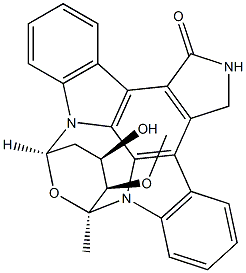1H-INDOLE-5-CARBOXAMIDE, 97%
Synonym(s):Indole-5-carboxamide;p38 MAP Kinase Inhibitor VII, SD-169 - CAS 1670-87-7 - Calbiochem
- CAS NO.:1670-87-7
- Empirical Formula: C9H8N2O
- Molecular Weight: 160.17
- MDL number: MFCD07779486
- SAFETY DATA SHEET (SDS)
- Update Date: 2024-11-19 23:02:33

What is 1H-INDOLE-5-CARBOXAMIDE, 97%?
The Uses of 1H-INDOLE-5-CARBOXAMIDE, 97%
1H-Indole-5-carboxamide (SD-169) is a p38α MAPK-selective inhibitor. 1H-Indole-5-carboxamide (SD-169) prevents the development and progression of diabetes in nonobese diabetic (NOD) mice by inhibiting T cell infiltration and activation.
The Uses of 1H-INDOLE-5-CARBOXAMIDE, 97%
SD 169 is a selective ATP competitive inhibitor of the MAP kinases p38α (IC50 = 3.2 nM) and p38β (IC50 = 122 nM). It has no inhibitory effect against a panel of other kinases, including p38γ MAP kinase, ERK2, JNK-1, and MAPKAPK-2, when tested in vitro at 50 μM. SD 169 is orally active, significantly reducing p38 MAP kinase expression in T cells of nonobese diabetic mice when delivered in chow at 600 mg/kg. In this model, SD 169 also reduced the incidence of diabetes, lowered blood glucose, and improved glucose homeostasis. SD 169 also enhances axonal regeneration after sciatic nerve crush injury in rats, when given by gavage (30 mg/kg) before and after nerve damage.
The Uses of 1H-INDOLE-5-CARBOXAMIDE, 97%
1H-Indole-5-carboxamide (SD-169) is a p38α MAPK-selective inhibitor. 1H-Indole-5-carboxamide (SD-169) prevents the development and progression of diabetes in nonobese diabetic (NOD) mice by inhibiting T cell infiltration and activation.
What are the applications of Application
SD-169 is a selective inhibitor of p38α and p38β
Definition
ChEBI: 1H-indole-5-carboxamide is an indolecarboxamide.
Biological Activity
Selective, orally active, ATP-competitive inhibitor of p38 α MAPK (IC 50 values are 3.2, 122 and > 50000 nM for p38 α , p38 β and p38 γ respectively). Demonstrates no activity against a range of other kinases including ERK2, JNK1 and MAPKAP2. Prevents development of diabetes and alleviates mild and moderate hyperglycaemic states in NOD mice.
References
[1] medicherla s, protter a a, ma j y, et al. preventive and therapeutic potential of p38α-selective mitogen-activated protein kinase inhibitor in nonobese diabetic mice with type 1 diabetes[j]. journal of pharmacology and experimental therapeutics, 2006, 318(1): 99-107.
[2] myers r r, sekiguchi y, kikuchi s, et al. inhibition of p38 map kinase activity enhances axonal regeneration[j]. experimental neurology, 2003, 184(2): 606-614.
Properties of 1H-INDOLE-5-CARBOXAMIDE, 97%
| Melting point: | 159-163 °C |
| Boiling point: | 457.6±18.0 °C(Predicted) |
| Density | 1.328±0.06 g/cm3(Predicted) |
| storage temp. | Sealed in dry,2-8°C |
| solubility | DMSO (Slightly), Methanol (Slightly) |
| form | Off-white solid |
| pka | 16.25±0.30(Predicted) |
| color | Off-White to Light Purple |
Safety information for 1H-INDOLE-5-CARBOXAMIDE, 97%
| Signal word | Warning |
| Pictogram(s) |
 Exclamation Mark Irritant GHS07 |
| GHS Hazard Statements |
H302:Acute toxicity,oral H315:Skin corrosion/irritation H319:Serious eye damage/eye irritation H335:Specific target organ toxicity, single exposure;Respiratory tract irritation |
| Precautionary Statement Codes |
P261:Avoid breathing dust/fume/gas/mist/vapours/spray. P264:Wash hands thoroughly after handling. P264:Wash skin thouroughly after handling. P270:Do not eat, drink or smoke when using this product. P301+P312:IF SWALLOWED: call a POISON CENTER or doctor/physician IF you feel unwell. P302+P352:IF ON SKIN: wash with plenty of soap and water. P305+P351+P338:IF IN EYES: Rinse cautiously with water for several minutes. Remove contact lenses, if present and easy to do. Continuerinsing. |
Computed Descriptors for 1H-INDOLE-5-CARBOXAMIDE, 97%
New Products
4-Fluorophenylacetic acid 4-Methylphenylacetic acid N-Boc-D-alaninol N-BOC-D/L-ALANINOL Tert-butyl bis(2-chloroethyl)carbamate 3-Morpholino-1-(4-nitrophenyl)-5,6-dihydropyridin- 2(1H)-one Furan-2,5-Dicarboxylic Acid Tropic acid S-2-CHLORO PROPIONIC ACID ETHYL ISOCYANOACETATE 2-Bromo-1,3-Bis(Dimethylamino)Trimethinium Hexafluorophosphate (6-METHYL-[1,3]DITHIOLO[4,5-b]QUINOXALIN-2-ONE INDAZOLE-3-CARBOXYLIC ACID 4-IODO BENZOIC ACID (2-Hydroxyphenyl)acetonitrile 4-Bromopyrazole 5,6-Dimethoxyindanone 2-(Cyanocyclohexyl)acetic acid 4-methoxy-3,5-dinitropyridine 2-aminopropyl benzoate hydrochloride 1-(4-(aminomethyl)benzyl)urea hydrochloride diethyl 2-(2-((tertbutoxycarbonyl)amino) ethyl)malonate tert-butyl 4- (ureidomethyl)benzylcarbamate Ethyl-2-chloro((4-methoxyphenyl)hydrazono)acetateRelated products of tetrahydrofuran
![3-[N-(2-Hydroxyacetyl)-4-piperidyl]-4-(4-pyrimidinyl)-5-(4-chlorophenyl)pyrazole](https://img.chemicalbook.in/CAS/20180713/GIF/271576-80-8.gif)







You may like
-
 SD169 >95% CAS 1670-87-7View Details
SD169 >95% CAS 1670-87-7View Details
1670-87-7 -
 p38 MAP Kinase Inhibitor VII, SD-169 CAS 1670-87-7View Details
p38 MAP Kinase Inhibitor VII, SD-169 CAS 1670-87-7View Details
1670-87-7 -
 1975-50-4 98%View Details
1975-50-4 98%View Details
1975-50-4 -
 2-HYDROXY BENZYL ALCOHOL 98%View Details
2-HYDROXY BENZYL ALCOHOL 98%View Details
90-01-7 -
 2-Chloro-1,3-Bis(Dimethylamino)Trimethinium Hexafluorophosphate 221615-75-4 98%View Details
2-Chloro-1,3-Bis(Dimethylamino)Trimethinium Hexafluorophosphate 221615-75-4 98%View Details
221615-75-4 -
 61397-56-6 CIS BROMO BENZOATE 98%View Details
61397-56-6 CIS BROMO BENZOATE 98%View Details
61397-56-6 -
 14714-50-2 (2-Hydroxyphenyl)acetonitrile 98+View Details
14714-50-2 (2-Hydroxyphenyl)acetonitrile 98+View Details
14714-50-2 -
 118753-70-1 98+View Details
118753-70-1 98+View Details
118753-70-1